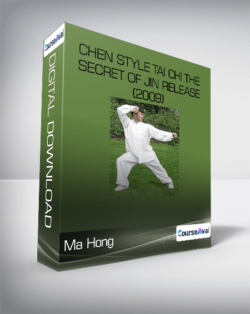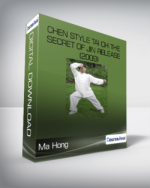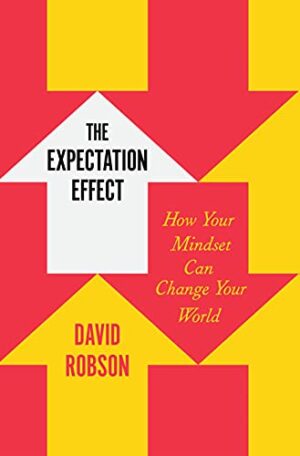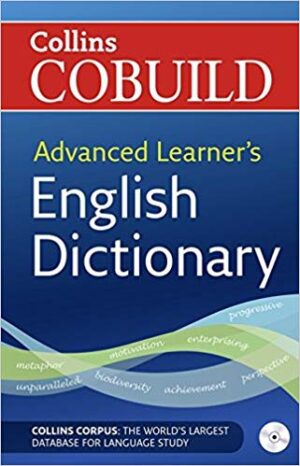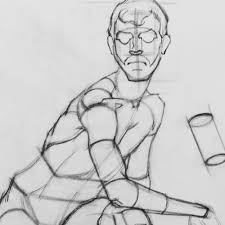PS: I apologise that some of the videos in this series end abruptly, but it can be assured that at most a tiny part is being cut off (around 1-2 seconds). This is because during the Webrip processing there will be bound to have some minor flaws.Purchase Chen Style Tai Chi The Secret of Jin Release (2009)-Ma Hong courses at here with PRICE $27.9 $25Ma Hong – Chen Style Tai Chi The Secret of Jin Release (2009)This is a Kung Fu training video on Tai Chi lectured by famous master Ma Hong.Ma Hong was the inner door student of Chen Zhao Kui, son of Chen Fa Ke. He started with Chen in 1972 after already having studied for ten years. He was soon delving deeper into the intricacies of Chen style.His concentrated efforts not only bore fruit in his performance but also set a standard of teaching and understanding which has become synonymous with the man himself. His explanations are direct and refreshingly clear. He has the aplumb of the instructor who “tells you like it is” without wavering. It’s up to you to decide whether or not you find it useful.Brief description of the productMa Hong has released another work to further elucidate and complement his earlier works, namely Routine I 83 Postures (I-III) and Routine II 71 Postures. In this series, the emphasis is on how to develop the release of the inner force, aka Fa Jin, while going through some of the movements in those earlier 2 works. It is well-known that Fa Jin is an important part of all Chinese martial arts; without being able to overcome the opponents’ strength or to exert your explosive inner force effectively, all martial arts merely become an elaborate display of movements and are ineffective in any practical application. Note that DVDs 1-6 are based on the Routine I 83 Postures (I-III) and DVDs 7-8 are based on Routine II 71 Postures.The following extract is taken from .Master Ma Hong and the Chen style Tai ChiIntroductionMaster Ma Hong, one of the most famous Tai Chi master in China, is the nineteenth generation of the Chen style Tai Chi. His teacher was Chen Dao Kuei, son of Chen Fah Ke (the seventeenth generation). Master Ma Hong believes the Chen style taught by his teacher, Chen Dao Kuei, just the right combination of hardness and softness and he said, according to Tai Chi Yin Yang, Tai Chi must be hard and soft; fast and slow; insubstantial and substantial; open and close. And also it must have Yi, Qi, Li (spirit, breath, strength) and all of these must be combined together in Tai Chi. Master Ma Hong also addressed the relationship between close and open whilst doing Tai Chi.He said entirely open is not good, and entirely closed is not good either. In addition to benefiting health, His teacher Chen Dao Kuei taught him not only each posture, but broke down the function, the martial use of each posture because Tai Chi also has its martial worth. I was following Master Ma Hong to learn Tai Chi for a few years, here I am going to summarise several features of the Chen style taught by my teacher and to discuss with other practitioners.Hardness and SoftnessTai Chi is a martial art rather than a sort of soft exercise, so the most important aspect in the Chen style Tai Chi is hardness and softness in close succession. For instance, a certain movement may look soft, but there is still force in it, such as Form 3 – Lazy About Trying Coat, the force from pushing two hands until the hip level is not a hard strength only; it is a “soft” and flexible strength with penetration. It can be expanded and contracted, therefore yielding both strength and relaxed softness. Only in this way hardness and softness can be performed. If all movement are hard (full of strength), it is not Tai Chi movement, reversely, if they are completely soft without hardness, this is not good either.In the Chen style, lots of movement seems to be suddenly fast and suddenly slow; suddenly soft and suddenly hard; suddenly disappear and suddenly appear. They, sometimes, look like soft water, and sometimes like hard ice. Furthermore, while the opponent’s movement is becoming soft, yours is getting softer than him; and the opponent’s movement is hard, yours is getting harder than him. Your opponent cannot see your softness because your softness is inside your body, and your opponent also cannot see your hardness because your hardness is inside too. In this case, the premium goal of the Chen style Tai Chi is whenever you want to use your soft power, you can have it, and whenever you want to use hard strength, you can have it. The Chen style is a system which the softness and hardness can be occurred at the same time.Spiral-like TwiningWith the flexibility of the whole body and proper body kinetics, spiral-like twining can be completed by joints, such as legs, waists, shoulders, elbow, spine, etc. Spiral-like twining is the ways of alternatively extending and withdrawing, of being tight and loose, and of firm and soft. Even though sometimes the person has to strike with the elbow or the forearm, the spiral-like twining power is still there. The principle of that is to extend all the way like a spiral, and then to release it.Because every movement has its hidden martial meanings, there is nothing that is empty in the whole forms. To create this sort of spiral-like twining, the waist is very important because it is the co-ordinator of body movement. And moreover, according to Traditional Chinese Medicine, the Qi comes from Diantian (2-3 cm below the umbilicus on the waist), by doing the spiral-like twining, the Qi can be directed by mental exertion to spread through to the whole body. Hence, such practice results in strengthened offensive and defensive force of the body and limbs as well as increased explosiveness of force.Arc-like MovementEach joint is connected to complete a great range of arc movement in the Chen style Tai Chi. The arc movement is help both for propelling the Qi circulation in the main and collateral channels (network) throughout the body and for transferring the internal power to extremities. On the other hand, the arc movement can also increase the stability because when doing arc-like movement, the body goes along the low curve to enhance stability for a certain step or position. This requires a good range of motion and strong muscles on the lower limbs (more pressure on them).Because some people don’t have a great range of motion and weak muscles on their lower limbs, so when they go low they cannot go any lower. Therefore they cannot conduct the arc-like movement, therefore, their stability are less than those who are going arc-like movement. Arc-like movement makes the whole body have Yin and Yang balance, in other word; it keeps the person in his own centre of gravity all the time. Only if you have controlled your centre of gravity, you can have the best body structure, and then you are able to have maximum power to your opponent.Opposite MovementMy teacher told me to remember the eight words: open and close, empty and full, spiral and turn, up and down. These words indicate the opposite movement existing in the Chen style. For example, in Form 21 – The Punch at Elbow’s Bottom, as soon as two hands are going up, the body needs to go down (up and down). In Form 19 – Push Both hands, while pushing hands forwards, the trunk slightly goes backwards (forwards and backwards). This opposite movement not only creates opposite force but also keeps the centre of gravity (balance) in the middle.The Chen style Tai Chi especially emphasizes this opposite movement. Another example, when pushing a heavy cart, first you need to pull backwards a bit before you push it forwards – opposite power! And when lifting a thing, you need to bend your knees first to yield opposite strength to lift it. So, all movements in the Chen style always have opposing movement/power inside the body. Like a tiger, if she is going to chase a prey, she will tighten her body, and then suddenly stretch its body to create opposite power to catch the prey.One Moves, Everything MovesThe Chen style is the oldest, it still contains a lot of martial contents. Although it looks soft, it does have instant hardness. When releasing it, Fah Jing (the techniques of releasing internal power) is occurred. But in order to achieve this, the important thing is how to transmit the internal power. My teacher told me the principle: ‘one moves, everything moves’. The Chen style not only requires using muscle but also needs to use bone, ligament, tendon, Qi, spiritual thinking and so on. Because of this way, a good practitioner is able to coordinate his different parts of body and to keep moving them to gather his maximum internal power either for issuing it or for redirecting the opponent’s force.Once one moves, everything moves, not just move the hands or the legs only! Hence, a practitioner needs to know something about Traditional Chinese Medicine (Jingluo theory), Anatomy and the theory of Yin and Yan. For example, when you use strength from your legs, you must know the meridian “San Yang”. Thus the energy (Qi) will go down along “San Yang (lateral meridian)” to the feet, and then the energy goes back to the interior meridian “San Yin”, it is a small Yin and Yan cycle. Therefore, when issuing energy, you must understand how to keep moving all relevant joints to let the Qi flow. Hereby, the internal power can be transferred lively and springy by means of constant movement.SummaryI just summarised a few characteristics of the Chen style I have learnt from my teacher. But, there are more features we need to identify and address, such as the techniques of how to borrow the opponent’s power; breathing techniques and so on. From my learning experience, in the beginning, the hardest thing is how to learn softness, in other word, how to relax muscles especially for the shoulder, elbow and wrist muscles. It does take a bit long time. After that, the next step is to improve strength by doing Solo single form, Push hand, Long pole, and Tai Chi ball. The last step is how to combine the softness and hardness together and transfer the internal power fluently and peacefully, like the wave of sea.In short, the Chen style is a kind of martial arts with ‘a serene heart plus a concentrated mind’, which allows the nerve centre to rest, improving ability to coordinate the functions of the various organs of the body. Relaxation of the whole body, deep and natural breathing, smooth arm-like actions and it aims at conveying one’s inner force to tips of the limbs by mental exertion, resulting in harmony of the inside and outside body. It is most suitable for both physical fitness exercise and self-defence training.Huang Xiaotong, Chen style Practitioner, SydneyNote: There are unfortunately no English Subtitles for this video. Also, this isn’t for those with just a casual and passing interest in Tai Chi and particularly The Chen style. The instructor Ma Hong has mentioned in the video that the things taught here are advanced in nature and require lots of hard work in order to be mastered. However, for the serious practitioner or people who are not put off by this warning, the video comprises some of the most comprehensive instruction on Chen style Tai Chi, and Ma Hong is clear and no-nonsense about his instruction so it isn’t difficult to understand the movements. Whether you are looking to further your expertise in Chen’s style Tai Chi or to improve your fitness or to learn to be able to fight effectively, if you put in hard work I believe the video shouldn’t disappoint you with its authentic and honest material.PS: I apologise that some of the videos in this series end abruptly, but it can be assured that at most a tiny part is being cut off (around 1-2 seconds). This is because during the Webrip processing there will be bound to have some minor flaws.Get Chen Style Tai Chi The Secret of Jin Release (2009)-Ma Hong at the CourseAvaiPurchase Chen Style Tai Chi The Secret of Jin Release (2009)-Ma Hong courses at here with PRICE $27.9 $25
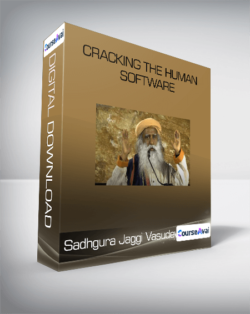 Cracking the Human Software-Sadhgura Jaggi Vasudev
₹4,150.00
Cracking the Human Software-Sadhgura Jaggi Vasudev
₹4,150.00
 Kahuna Secrets of Dipping into the Ocean of Money-John La Tourrette
₹4,150.00
Kahuna Secrets of Dipping into the Ocean of Money-John La Tourrette
₹4,150.00
Chen Style Tai Chi The Secret of Jin Release (2009)-Ma Hong
₹4,150.00

